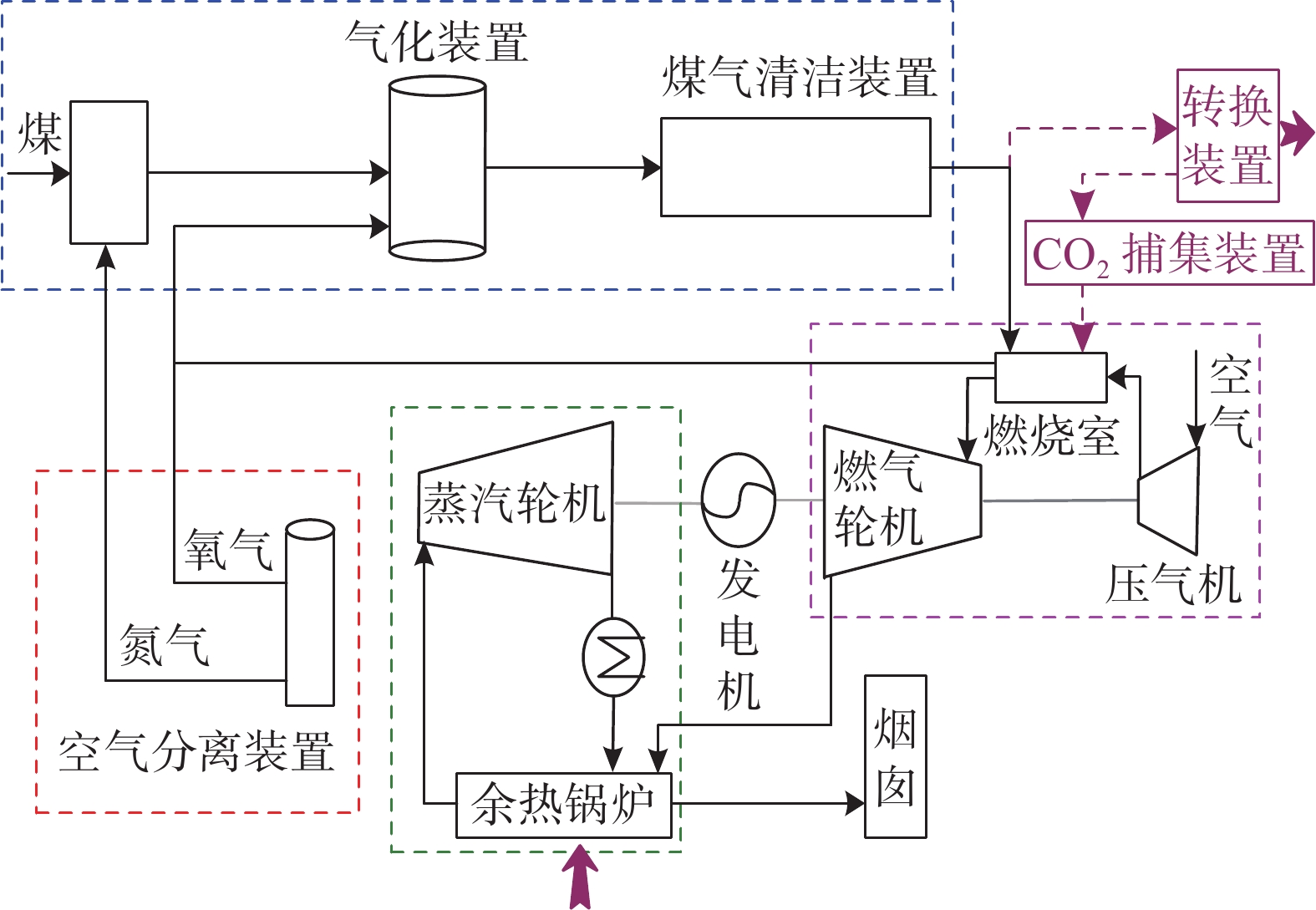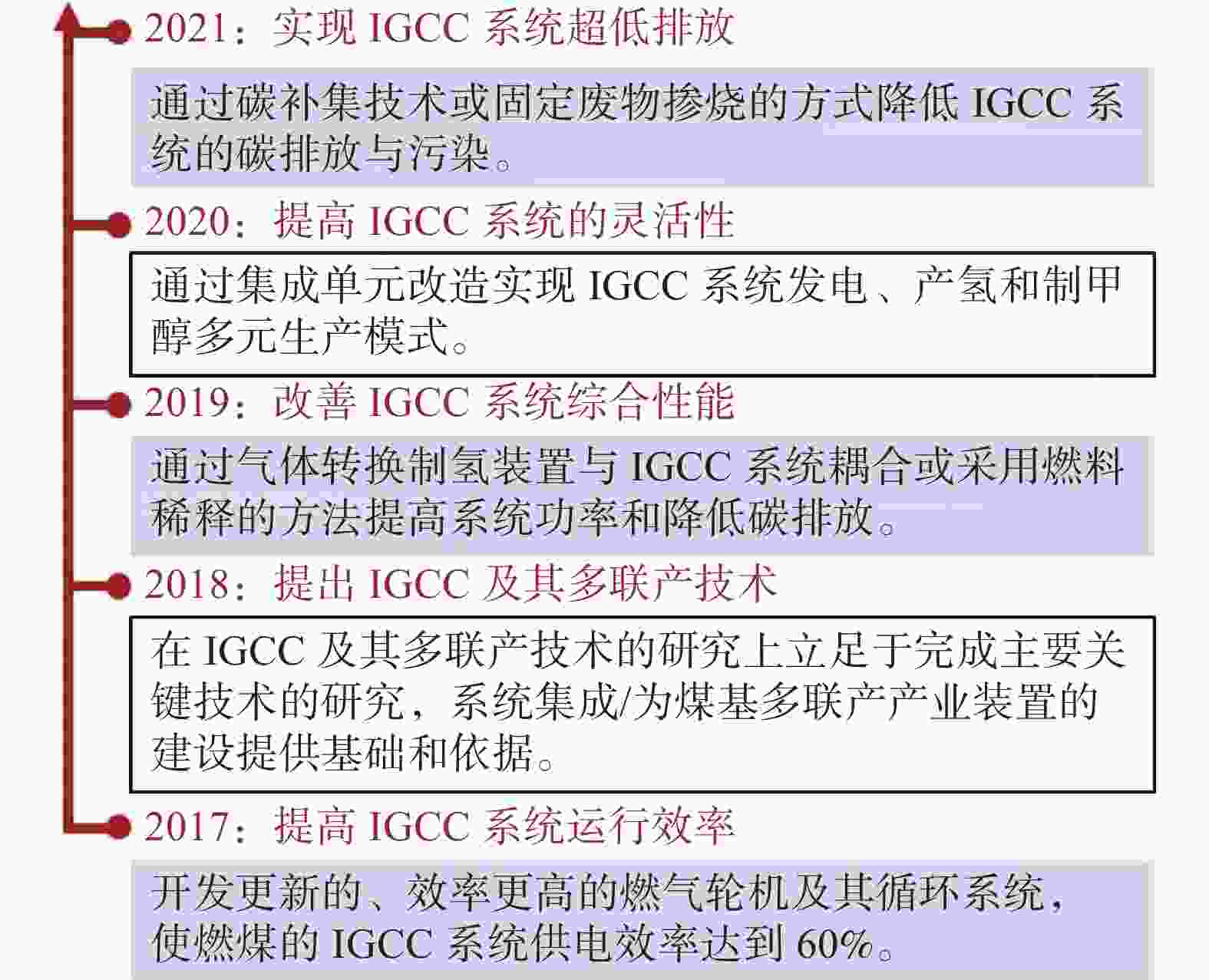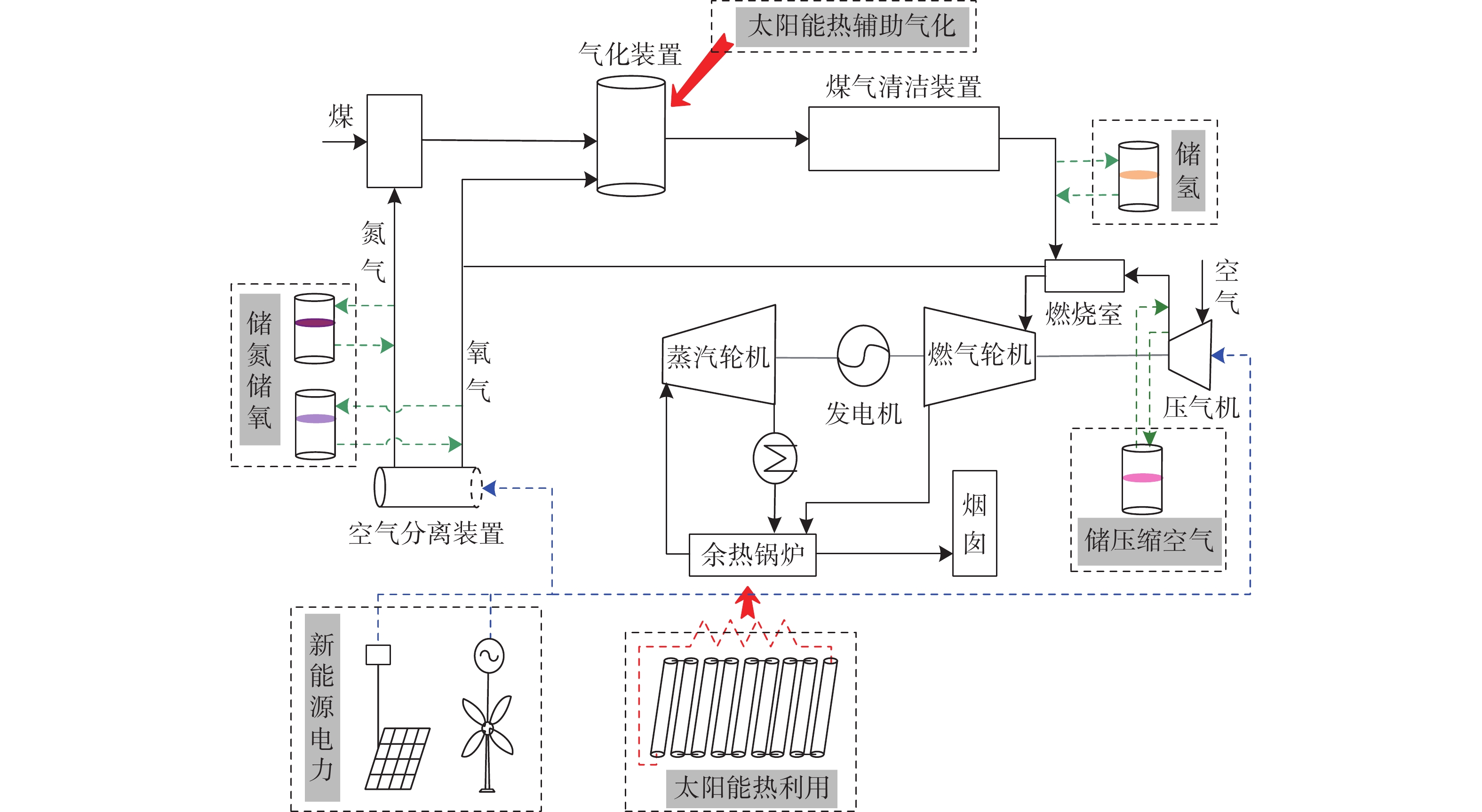-
在“双碳”目标下,煤气化联合发电技术(Integrated Gasification Combined Cycle,IGCC)在低成方面具有较大的应用潜力[1],IGCC发电系统是实现煤炭资源清洁转型的重要方式之一。研究表明,采用燃料调控和多能互补等方法构筑新型IGCC发电系统可以进一步降低IGCC发电系统的CO2排放。Carlos等[2]发现将气体转换燃烧与IGCC系统相结合能够提高CO2捕获率,并明显改善系统效率。Ahme等[3]提出将甲烷重整技术与IGCC发电技术相结合,将水煤浆气化过程中的高焓值水蒸气用于辅助重整过程制取氢气。该集成系统为吸热重整过程提供了热量,同时提高了合成气的热值和系统的性能,减少了CO2排放。
然而,上述IGCC系统复杂性较高,实验测试成本高,直接增加了系统性能研究的难度。在此背景下,谢浩等[4]通过数值分析确定了IGCC系统中汽水配置方式对系统整体性能的影响,并基于相关部件组建了IGCC系统通用模型,进一步对系统结构进行了优化,提高了系统能量利用率。Kapetaki等[5]通过对比壳式气化炉与通用电能气化炉在配置和没有配置碳捕集装置情况下对IGCC系统性能的影响,研究表明当系统配置碳捕集和通用电能气化炉时净效率损失较低。由此可见,采用数值模拟的研究手段对IGCC系统进行设计与优化展现出了显著的优势。
IGCC发电技术既有高发电效率,又有极好的环保性能,是一种有发展前景的洁净煤发电技术。本文首先对近年来国内开展的新型IGCC系统研究所取得的进展进行总结和归纳。进一步地,基于此解析新型IGCC系统分别与煤气化、风电、光电等新能源系统的集成结构及其工作原理,并针对IGCC系统未来的研究方向进行分析与展望。期望为后续构建新型IGCC系统、对相关系统的优化设计提供参考与解决思路。
-
IGCC系统是一个多设备集成的能源转换利用系统,其结构如图1所示。系统主要由空气分离系统、煤气化及煤气净化系统、燃气轮机系统、余热锅炉驱动的蒸汽轮机系统四个常规部分组成。IGCC工艺流程可简单描述为:首先,在空分系统中进行空气分离,产生氮气和氧气。然后,气化炉中水煤浆或干粉与气化介质(蒸汽、氧或空气)发生气化反应,生成煤气(以CO、H2为主要成分)。随后,煤气进入净化系统,经过净化装置获得洁净的煤气。理论上,提高气化炉中氧气浓度能够提高煤气化速率,实践中可通过改变空分功率或增设氧气储罐等方法实现[6],但由此会带来CO2排放量增加。
在增设碳捕集的需求下,学者对原有的IGCC系统进行了优化。例如,Descamps等[7]在基础IGCC系统气化流程的下游添加了转换装置,将净化后的燃料气送入了该转换装置(主要为在水蒸气的作用下将含碳气体更高比例地转化为CO2),进而实现燃烧前碳捕集,同时将转化过程所释放的能量以水/水蒸汽为载体送入余热锅炉。
除了对IGCC系统结构进行优化之外,改变IGCC发电系统的燃料也能够实现CO2减排效果。IGCC发电系统的常规燃料主要包含块煤、焦炭、干煤粉等,见表1。为了实现CO2减排和固废处置,还可以采用掺烧碎木、树皮、城市可燃垃圾等。在煤与生物质共气化的过程中,提高生物质的比例可以提高煤的反应活性,且由于碳中性的生物质加入,能够实现降低发电过程中的CO2排放[8]。
燃料种类 燃料应用 烟煤 NA Abaimov等[9]以烟煤为燃料,
进行大功率综合气化
联合循环的气化炉研制,
提出的气化炉结构
不仅可以提高
合成气中氢气含量,
还可以提高燃气轮机效率。褐煤 A Giuffrida等[10]以褐煤为燃料,
基于质量和能量平衡,
对CO2与燃烧捕集进行了讨论。木屑 Hairong Wang等[11]以木屑为燃料,
利用生物质气化技术
设计了燃气-蒸汽联合循环,
分析了气化反应器的参数、
能量转化过程的热工性能等。焦炭 Okeke I J等[12]以焦炭为燃料,
利用Aspen Plus v10中模拟了一种
新型焦炭发电装置,将其
与以往的发电装置进行对比,
可有效降低温室气体排放
和改善化石燃料耗竭情况。固体废弃物 Subramanyam V等[13]以固体废弃物为燃料,
利用等离子体气化技术,
将生活垃圾转化为电能,
有效改善资源浪费和环境污染问题。Table 1. IGCC solid fuel diversity
-
IGCC发电作为一种超洁、高效的发电技术,在碳减排方面具有极大的应用潜力。主要体现在以下两方面:一方面由于IGCC发电系统采用富氧或纯氧加压气化技术,这使得所分离的气体体积大幅度减小、CO2浓度显著增大,从而大大降低了分离过程的能耗和设备投资,成为低成本燃烧前CO2补集技术的首选;另一方面IGCC发电系统具有极大的灵活性和可扩充性,可以与其他清洁、可再生能源进行耦合,现多能互补与平衡、提高能源资源利用率。
-
IGCC多联产系统是指将IGCC发电和煤化工、热泵等技术耦合的能源系统,这样的能源系统能够实现温度、压力、物质成分的梯级利用,进而达到提高效率、减少污染物排放的目的。
IGCC系统的蒸汽轮机排汽部分与常规燃煤机组一样,直接通入凝汽器会造成较大的冷端余能损失。采用抽汽的方式来驱动吸收式热泵回收乏汽余能,不仅能够保留其灵活性,还可大大降低冷端余能损失,实现能量的梯级利用[14],系统结构如图2所示。
李召召等[15]提出煤气化产物中,部分高氢产物除供给煤化工使用以外,还可在需要时用以制备甲醇或电力。IGCC–甲醇系统也是一种IGCC多联产能源利用系统,过程中可以获得氧气和氮气副产品。由此可见,IGCC发电系统的复杂性使其具备了空气分离、煤气化以及高参数蒸汽等多种能量载体,根据实际的产品需要,优化各单体的运行参数具有进一步提效的潜质。
-
在“双碳”目标之下,将IGCC与其他清洁、可再生能源进行耦合应用是IGCC系统的重要发展方向之一。IGCC多能耦合发电系统主要包括将新能源电力嵌入、新能源热嵌入以及储能技术嵌入。IGCC系统与多种能源耦合的形式可归纳如图3所示。
新能源电力嵌入主要是指将波动性的新能源电力用于空气分离装置,利用气体储罐来平抑新能源电力出力的波动性,同时还可以降低IGCC系统能耗。袁铁江等[16]构建了风电–氢储与煤化工多能耦合系统的基本架构,使电网不能消纳的富裕风电通过电解水制氢、储氢得到了有效利用,储存的氢气可在需要时用于发电以平抑风电对电力系统的安全稳定运行的掣肘。美国能源部[17]使用间接加热热管驱动的气化反应器与塔式聚光太阳能相结合,有效减少了当前气化过程中的碳排放。杨承等[18]通过对IGCC中燃气轮机冷热电联产系统分析建模,将太阳能储热系统与IGCC系统进行耦合,结果指出该方法能够有效改善系统运行性能。
综上所述,IGCC多能耦合发电系统可将多元化的能源载体实施有机结合,从发电侧和用户侧多途径提高能源系统的灵活性与效率。
-
数值模拟在IGCC系统的理论研究中发挥了重要作用,常见的仿真工具包括Aspen Plus、Ebsilon、Thermoflow-GTPRO等软件,各软件的应用特点见表2。各个软件对IGCC系统建模的侧重性各有不同。Aspen具有较为完备的物性参数数据库,比较擅长对系统的整体性能进行评估,同时可以反映气化过程的物质变化;但对于系统分组件的功率值测定却显得捉襟见肘。通过该软件可对整个煤气化过程进行分析,寻找最优操作点,提高整个过程的热效率,达到过程优化的目的。Ebslion软件可以通过建立稳态变工况模型来计算能量的传递情况,但无法实现机组的在线检测。通过该软件可计算得到机组变工况特性曲线和热电联产运行时的热电负荷特性等参数。GTPRO在系统搭建和全流程模拟方面具有更易于实现的特点,但其所建立的气化炉模型较为简单,模型的精确度不高。通过该软件可实现IGCC热力系统性能指标计算机优化分析。Matlab求解模型灵活实用,可以获得较为准确的数据,具有较高的精确度,同时可以在其他编程语言的环境下进行二次开发,但求解过程极其复杂繁琐。通过该软件综合考虑物料平衡和热量平衡,较为精准地模拟了气化炉内气化特性。
软件 优点 缺点 参考文献 Aspen Plus 数据库建设庞大,物性参数完备,计算精确,可以进行IGCC的整体性能评估以及具有
解决资源冲突的能力。对于合并能源的IGCC系统难以测量能量值,收集各个组件的功率值过程复杂。 [19] Ebsilon 对IGCC发电系统更有针对性,建立变工况计算模型更方便优化,能够精确计算物质能量的传递,通过可以通过输入输出的平衡计算得到传质传热组件的参数,适用多种热工介质,
集成大量热力模型。不支持方向流过程和系统的建模,不能直接用于机组在线监测。 [20][21][22] Thermoflow-GTPRO 常用于IGCC系统热平衡计算,系统模型的建立和流程模拟易实现。 IGCC建模时,气化炉模型较简单,需要考虑平衡态输出,燃机模型没有运行特性曲线,仅通过修改压比,调整透平进气温度等进行修正,精确度不高,
空分仅能采用外压缩流程。[23] MATLAB 数值稳定性好,使用方便,在化工计算中得到广泛应用,最优化工具箱中提供的非线性方程组求解函数fsolve能够快速、准确地完成能量平衡方程组和能量平衡方程的求解。 该模型包含的方程多、未知量多,
求解计算过程较复杂。[24] Table 2. Advantages and disadvantages of each software in IGCC application field
-
近年来IGCC系统的研究热点如图4所示。未来煤炭仍将在相当长一段时间里占据我国生产生活主要能源的地位。随着制造工艺和技术的发展改革,煤炭发电技术也快速向更高效、更环保的目标发展。
对于IGCC系统的发展,一方面,学者们对如何提高IGCC系统的效率做了大量的研究,通过采用高压空分设备与燃气轮机一体化[25]和对合成气预处理[26]等方法都能够显著地提高IGCC系统的净效率,另一方面,也在积极地探寻IGCC系统与多种技术耦合实现多元联产的生产过程。通过IGCC系统与固废掺混燃烧技术[27]、太阳能储热系统[28]以及甲醇制备系统[29]进行耦合生产,实现能量的多元利用的同时,扩宽电厂的工业生产销售渠道,提高电厂的经济效益。
同时,在“双碳”目标的指引下,如何降低IGCC发电系统的污染也成为了一个研究热点。目前的热点主要集中于如何提高CO2的捕集率。主要方法主要有使用化学链空分装置[30]、制氧预燃[31]、水煤气转换[32]和钙环气化(CLG)[33]等技术实现CO2的超低排放。
除此之外,以煤气化为基础、以电力生产为核心,将IGCC与煤化工、热泵等技术耦合的多联产系统将是我国以煤为基础的新型能源转化系统技术的重点发展方向之一。而通过数值模拟的方法,可以对IGCC系统的固废掺混的燃烧模拟和碳捕集等方面继续开展深入研究,为其进行工程应用提供理论支撑。我国IGCC及其多联产技术的发展应该主要集中在提高机组循环效率和工作可靠性,以及与多联产技术进一步融合和控制CO2减排三个方面。实施多联产示范工程,带动我国洁净煤关键技术和装备的发展,为实现煤炭洁净、高效利用升级提供技术支撑,形成可持续发展的新型能源转化技术系统。
-
随着未来能源与环境可持续发展的要求与标准不断提高,新型IGCC发电系统由于借其自身的高效性和对固体燃料多样性的适应能力,或通过耦合多能(可再生能)系统、多联产系统,必将拥有更广阔的应用空间。本文从IGCC系统的燃料的多样性、系统耦合多能联产技术、系统仿真模拟的软件要总结归纳如下:
1) IGCC发电系统适用于多种不同燃料的气化应用,通过添加调控燃料可以实现CO2排放、发电效能的提高,且该方案在实际实践中最为简便。
2) 通过耦合煤化工艺工、储能技术等工艺,引入风电、光电等构筑新型IGCC发电系统,由此带来更可观的经济和功能上的附加值,包括产氢、碳捕集、储能调峰等。
3) 通过采用数值模拟的方法可以为IGCC系统结构的优化设计与多能耦合提供理论支撑。
Research on the Trend of IGCC Power Generation System and Optimization Method Under the Background of Carbon Reduction
doi: 10.16516/j.gedi.issn2095-8676.2022.03.015
- Received Date: 2022-06-28
- Accepted Date: 2022-07-05
- Rev Recd Date: 2022-07-05
- Available Online: 2022-09-26
- Publish Date: 2022-09-25
-
Key words:
- coal gasification combined cycle /
- fuel diversity /
- system diversity /
- simulation /
- technology outlook
Abstract:
| Citation: | ZHANG Yu, ZHENG Minghui, JING Luyao, XIAO Simin, YANG Haoran, YANG Huaiyu, FAN Xiaoya. Research on the Trend of IGCC Power Generation System and Optimization Method Under the Background of Carbon Reduction[J]. SOUTHERN ENERGY CONSTRUCTION, 2022, 9(3): 127-133. doi: 10.16516/j.gedi.issn2095-8676.2022.03.015 |











 DownLoad:
DownLoad:


